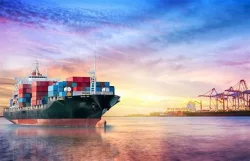Aspects of ocean freight
2023-11-24
Ocean freight, also known as sea freight, is a mode of transportation that involves the shipping of goods by sea. It is a crucial component of international trade, facilitating the movement of large quantities of goods across oceans. Ocean freight is well-suited for transporting bulky, heavy, or non-perishable items over long distances. Here are key aspects of ocean freight:
1. Containerized Shipping:
- Containerization: Goods are typically transported in standardized containers, facilitating easy handling and transfer between different modes of transportation (e.g., ship to truck or ship to rail).
- Container Types: Common container sizes include 20-foot and 40-foot containers, and specialized containers exist for specific cargo types (e.g., refrigerated containers for perishable goods).
2. Full Container Load (FCL) and Less Than Container Load (LCL):
- FCL: In FCL shipping, a shipper books and pays for the entire container, which is exclusively used for their goods.
- LCL: In LCL shipping, multiple shippers share a container, each paying for the space their goods occupy. This is cost-effective for smaller shipments.
3. Port-to-Port and Door-to-Door Services:
- Port-to-Port: Goods are transported from one port to another, and the responsibility of the shipment transfers between parties at the ports.
- Door-to-Door: Freight forwarders may provide door-to-door services, managing the entire logistics process from the shipper's location to the recipient's destination.
4. Major Container Shipping Routes:
- East-West Trade Routes: Major routes include those connecting Asia and Europe, Asia and North America, and Europe and North America.
- North-South Trade Routes: Routes connecting Northern and Southern Hemisphere regions, such as North America and South America.
5. Transshipment and Hub Ports:
- Transshipment: Some shipments involve multiple carriers and may require transfers between vessels at hub ports.
- Hub Ports: These are major ports where goods are transshipped and distributed to various destinations.
6. Ocean Freight Carriers:
- Shipping Lines: Major container shipping lines operate large vessels that transport goods globally.
- Alliances: Shipping lines often form alliances to share vessel capacity and improve efficiency.
7. Container Tracking:
- Visibility and Tracking: Many ocean freight carriers provide tracking services, allowing shippers to monitor the location and status of their shipments in real-time.
8. Booking and Documentation:
- Booking: Shippers book space on vessels through freight forwarders or directly with carriers.
- Documentation: Shippers and freight forwarders handle various documents, including bills of lading, commercial invoices, and customs declarations.
9. Port Infrastructure and Customs Clearance:
- Port Facilities: Ports play a crucial role in loading and unloading vessels, and the efficiency of port operations impacts overall shipping timelines.
- Customs Clearance: Ocean freight shipments involve compliance with customs regulations, and customs clearance procedures vary by country.
10. Risks and Insurance:
- Cargo Insurance: Shippers often purchase cargo insurance to protect against the risks of damage, loss, or theft during transit.
Ocean freight is a cost-effective and reliable option for transporting goods on a global scale. It is particularly well-suited for businesses engaged in international trade that require the movement of large volumes of goods between continents.



